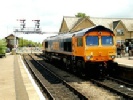Archive Section




© Cameron Tyre.
From the June 1997 Newsletter, so written shortly after the franchising of ScotRail.
The Depot’s History.
There has been a railway depot on the site at Corkerhill since 1st December, 1896, when The Glasgow & South Western Railway opened a new facility for the fuelling and servicing of locomotives. This was needed to relieve the cramped conditions found in the shed adjacent to St. Enoch station in the Glasgow City Centre. A staff halt, which opened the same day as the depot, was built on the Paisley Canal line which runs past. This must have been a boon to those who worked there in the early days, because in the year of its opening, the depot was situated in a semi-
At the ‘Big Four’ grouping in 1923, the Glasgow and South Western, along with its sworn enemy the Caledonian, became part of the London, Midland and Scottish Railway; they were to be masters of the men and machines at Corkerhill for the next quarter of a century. In 1948, the ruling Labour government decided upon the ultimate integration of the nation’s rail network with the formation of the nationalised British Railways, the railway arm of the British Transport Commission.
Since nationalisation, Corkerhill has witnessed the transition from steam to diesel and, nowadays, electric as well. The line from the depot to Shields Junction was electrified for the coming Ayrshire electrified services and the 90 mph Class 318 E.M.U.’s, in 1986.
In the years since 1948, the British Transport Commission handed over control of British Railways to the purpose-
The Scene Today:
From a depot threatened with closure in 1984, Corkerhill has clawed its way back to become an essential part of ScotRail’s day to day operations. It currently maintains, services and deans a fleet of Class 101 and 156 diesel multiple units and also provides cleaning facilities for Class 303 (Glasgow “Blue Trains”), 318 and 325 E.M.U.’s. There are also two Class 936 sandite application units (formerly Class 311). The E.M.U’s receive their maintenance at nearby Shields E.I.D.
Today there are 108 drivers based at the depot, although a fair number of the diagrams require them to book on and off duty in the city, at Glasgow Central. Sometimes this leads to the situation where a driver does not see his home depot for a number of weeks, whilst he is working diagrams that are ‘Central book-
All of the services involved originate or terminate Glasgow Central, apart from the twice a day, each way cross-
The Depot Today:
The track layout consists of, from North to South, No’s 1 & 2 sidings, Old Fuel Road, then the 1950’s amenity block in between two dead-
Entry to the depot from the Paisley Canal line is controlled by signal S1, under the control of a small panel in the Yard Supervisor’s office. Departure is authorised by the shunter, who gives permission for a train to draw up to the yard exit signal, G598, controlled by Glasgow Central Signalling Centre. On entering the depot, after S1 signal, the track diverges into three reception lines, No’s 1 to 3. The first two have fuelling facilities for the D.M.U.’s. There is still a small fuel point on the Old Fuel Road, but it is normally only used to fuel visitors, such as the Class 08 or 09 shed pilot from Polmadie, which has no refuelling facilities of its own. Also fuelled are the weed killing train, which is powered by the Hunslet-
The normal procedure for a D.M.U. entering the depot is:
- Fuelled;
- Up to the West end shunt neck (which is actually in the old Paisley bound platform at Corkerhill station) via the carriage washing machine (CWM);
- Stabled in either a maintenance road if remedial or routine attention is required, or a shed road, with the 101 ‘s always being stabled in No. 1 Shed Road.
The E.M.U.’s normally enter the depot via No. 3 reception line, as this has no fuelling facilities, then as per the D.M.U.’s via the CWM to the shunt neck. Then they are stabled in either the sidings, departure roads or shed roads 1 to 3.
Overview of the ScotRail Fleet:
Overall, ScotRail runs its services with a fleet of 259 D.M.U.’s, 332 E.M.U.’s and 80 locomotive hauled vehicles. Locomotives are hired as necessary from either West Coast or English, Welsh & Scottish. The National Express Group is promising a fleet of 38 three-